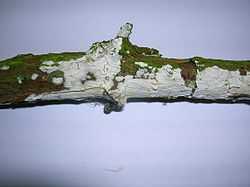Hyphodontia sambuci
| Hyphodontia sambuci | |
|---|---|
 | |
| Elder Whitewash on Elder (Sambucus nigra) in North Ayrshire, Scotland | |
| Scientific classification | |
| Kingdom: | Fungi |
| Phylum: | Basidiomycota |
| Class: | Basidiomycetes |
| Subclass: | Incertae sedis |
| Order: | Hymenochaetales |
| Family: | Schizoporaceae |
| Genus: | Hyphodontia |
| Species: | H. sambuci |
| Binomial name | |
| Hyphodontia sambuci (Fr.) J. Erikss., (1958) | |
| Synonyms | |
|
Hyphoderma sambuci (Pers.) Julich. | |
Hyphodontia sambuci or Elder Whitewash is a basidiomycete fungal pathogen on deadwood, especially elder.[1]
It is resupinate, forming a very thin structure which is white, pruinose (flour-like dusting) or chalky in appearance. It is inedible.[1] It also grows on dead but still hanging branches of Fraxinus, Berberis, Nothofagus, Ulmus, Populus, Hedera, Ribes, Symphoricarpus and rarely on conifers such as Cryptomeria.[2]
Ecology
As stated, H. sambuci occurs in North Europe mostly on Sambucus nigra, but there is a much bigger spectrum of substrates in warmer regions in southern areas. The variability of micromorphology increases in the tropics, but the macromorphological characteristics however always stay the same: the basidiocarp with chalky white color and often growing as aerophyte on dead branches of trees and bushes, that are still attached to the tree. H. sambuci consists of a complex of species. Similar species with capitate cystidia ; thin-walled hyphae and exactly the same chalky white fruit body are H. griselinae and H. fimbriata. The can be differentiated by their spores and morphology of their basidiocarp.[2]
External links
- The Virtual Field Guide.
- Index Fungorum.
- USDA ARS Fungal Database.
- The National Biodiversity Network Gateway.
- World Wide distribution details
References
- ↑ 1.0 1.1 Phillips, Roger (2006), Mushrooms. Pub. McMilan, ISBN 0-330-44237-6. P. 322.
- ↑ 2.0 2.1 The Whitewash Elder.